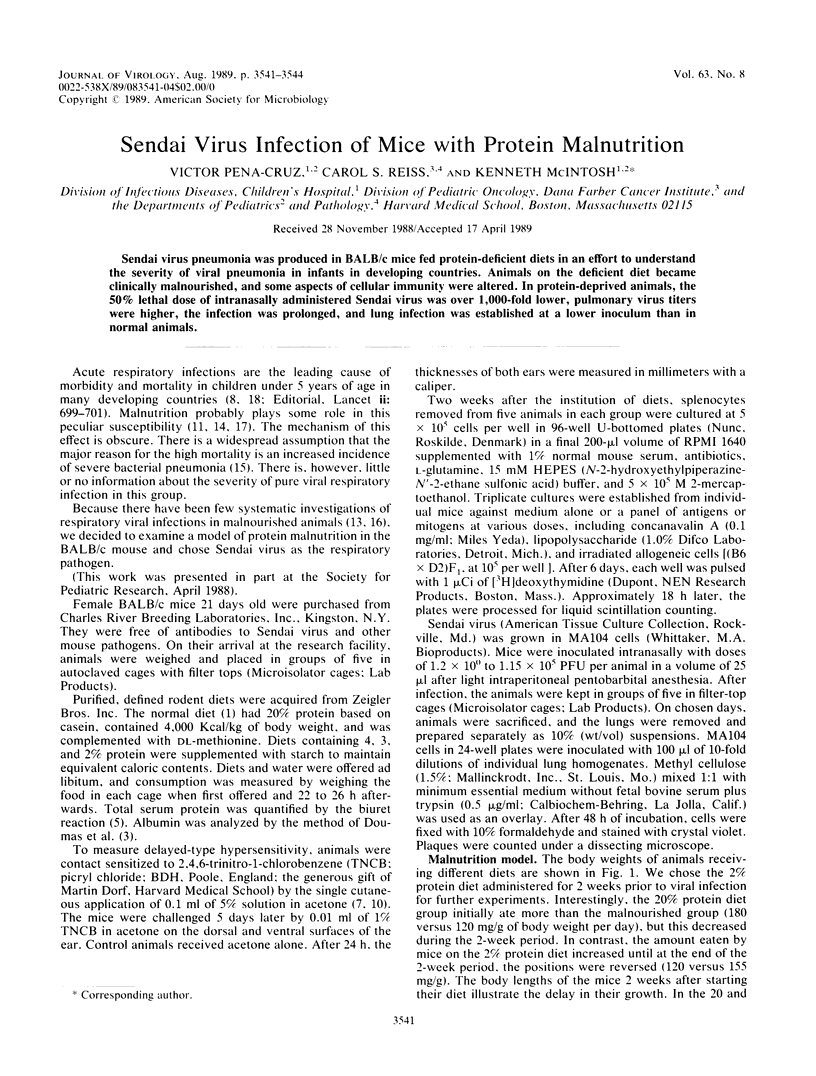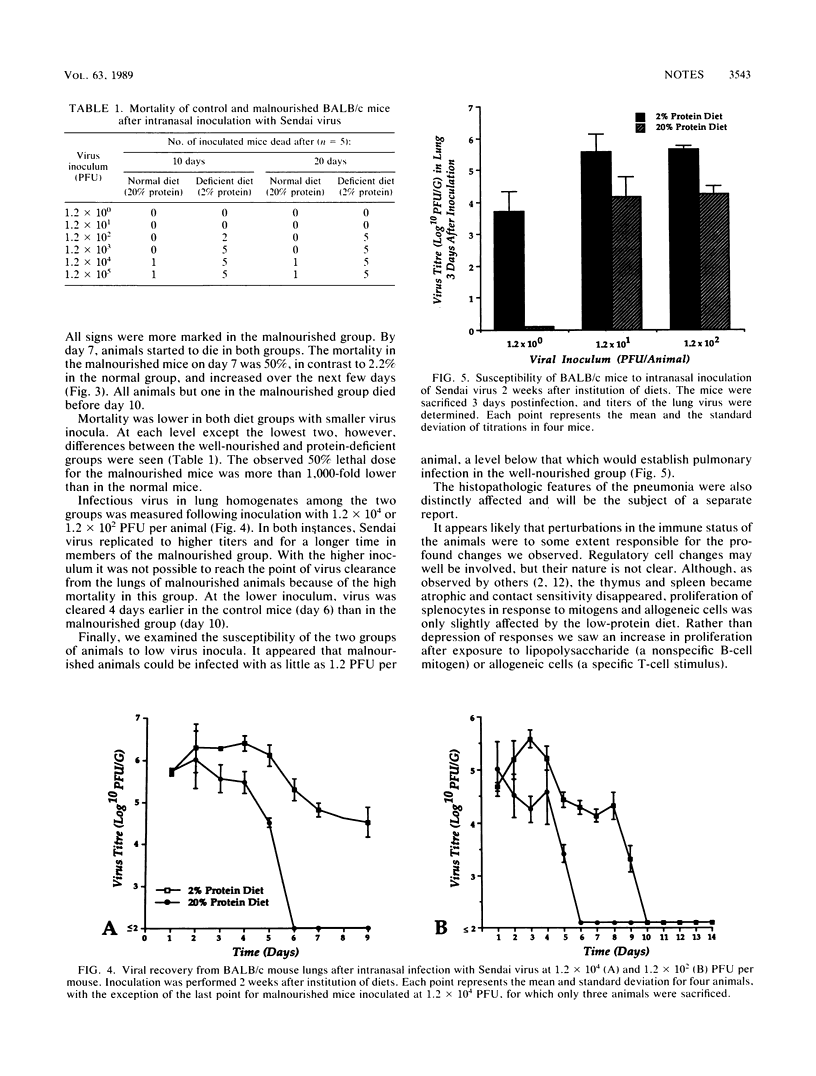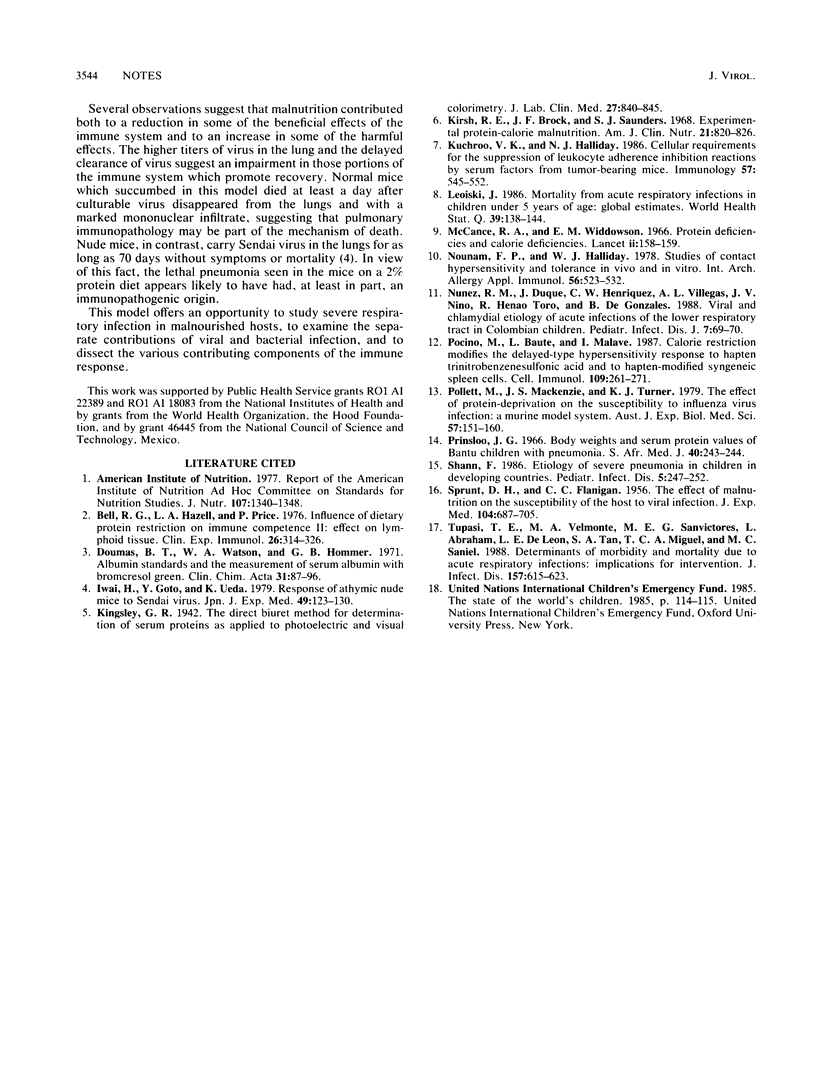Abstract
Sendai virus pneumonia was produced in BALB/c mice fed protein-deficient diets in an effort to understand the severity of viral pneumonia in infants in developing countries. Animals on the deficient diet became clinically malnourished, and some aspects of cellular immunity were altered. In protein-deprived animals, the 50% lethal dose of intranasally administered Sendai virus was over 1,000-fold lower, pulmonary virus titers were higher, the infection was prolonged, and lung infection was established at a lower inoculum than in normal animals.
Full text
PDF



Selected References
These references are in PubMed. This may not be the complete list of references from this article.
- Bell R. G., Hazell L. A., Price P. Influence of dietary protein restriction on immune competence. II. Effect on lymphoid tissue. Clin Exp Immunol. 1976 Nov;26(2):314–326. [PMC free article] [PubMed] [Google Scholar]
- Doumas B. T., Watson W. A., Biggs H. G. Albumin standards and the measurement of serum albumin with bromcresol green. Clin Chim Acta. 1971 Jan;31(1):87–96. doi: 10.1016/0009-8981(71)90365-2. [DOI] [PubMed] [Google Scholar]
- FLANIGAN C. C., SPRUNT D. H. The effect of malnutrition on the susceptibility of the host to viral infection. J Exp Med. 1956 Nov 1;104(5):687–706. doi: 10.1084/jem.104.5.687. [DOI] [PMC free article] [PubMed] [Google Scholar]
- Iwai H., Goto Y., Ueda K. Response of athymic nude mice to Sendai virus. Jpn J Exp Med. 1979 Apr;49(2):123–130. [PubMed] [Google Scholar]
- Kirsch R. E., Brock J. F., Saunders S. J. Experimental protein-calorie malnutrition. Am J Clin Nutr. 1968 Aug;21(8):820–826. doi: 10.1093/ajcn/21.8.820. [DOI] [PubMed] [Google Scholar]
- Kuchroo V. K., Halliday W. J. Cellular requirements for the suppression of leucocyte adherence inhibition reactions by serum factors from tumour-bearing mice. Immunology. 1986 Apr;57(4):545–552. [PMC free article] [PubMed] [Google Scholar]
- McCance R. A., Widdowson E. M. Protein deficiencies and calorie deficiencies. Lancet. 1966 Jul 16;2(7455):158–159. doi: 10.1016/s0140-6736(66)92439-1. [DOI] [PubMed] [Google Scholar]
- Noonan F. P., Halliday W. J. Studies of contact hypersensitivity and tolerance in vivo and in vitro. I. Basic characteristics of the reactions and confirmation of an immune response in tolerant mice. Int Arch Allergy Appl Immunol. 1978;56(6):523–532. [PubMed] [Google Scholar]
- Nunez R. M., Dugue J., Henriquez C. W., Villegas A. L., Niño J. U., De Gonzales B. Viral and chlamydial etiology of acute infections of the lower respiratory tract in Colombian children. Pediatr Infect Dis J. 1988 Jan;7(1):69–70. doi: 10.1097/00006454-198801000-00016. [DOI] [PubMed] [Google Scholar]
- Pocino M., Baute L., Malavé I. Calorie restriction modifies the delayed-type hypersensitivity response to the hapten trinitrobenzenesulfonic acid and to hapten-modified syngeneic spleen cells. Cell Immunol. 1987 Oct 15;109(2):261–271. doi: 10.1016/0008-8749(87)90310-8. [DOI] [PubMed] [Google Scholar]
- Pollett M., Mackenzie J. S., Turner K. J. The effect of protein-deprivation on the susceptibility to influenza virus infection: a murine model system. Aust J Exp Biol Med Sci. 1979 Apr;57(2):151–160. doi: 10.1038/icb.1979.16. [DOI] [PubMed] [Google Scholar]
- Prinsloo J. G., Pretorius P. J. Body-weights and serum protein values of Bantu children with pneumonia. S Afr Med J. 1966 Mar 19;40(11):243–244. [PubMed] [Google Scholar]
- Shann F. Etiology of severe pneumonia in children in developing countries. Pediatr Infect Dis. 1986 Mar-Apr;5(2):247–252. doi: 10.1097/00006454-198603000-00017. [DOI] [PubMed] [Google Scholar]
- Tupasi T. E., Velmonte M. A., Sanvictores M. E., Abraham L., De Leon L. E., Tan S. A., Miguel C. A., Saniel M. C. Determinants of morbidity and mortality due to acute respiratory infections: implications for intervention. J Infect Dis. 1988 Apr;157(4):615–623. doi: 10.1093/infdis/157.4.615. [DOI] [PubMed] [Google Scholar]


